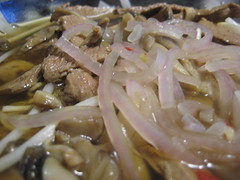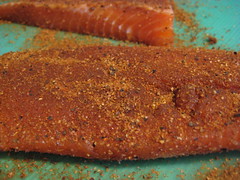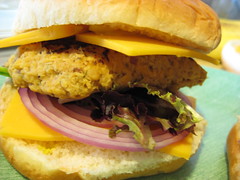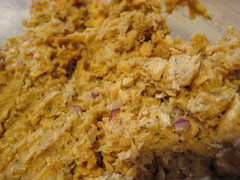As I just alluded to above, the beef broth for pho is normally a home-made stock, traditionally using oxtails as the base (you may have noticed that I switched terms there. I define stock as a liquid made from the meat and bones of an animal, and broth as any flavored liquid that accompanies other additions. So in this case, the end result is a broth that's made using stock. Its a little odd, I know.). I'm not ashamed to admit that in this case, I cheated and used a packaged beef stock. Kitchen Basics Unsalted Beef Stock to be precise. Why did I go with that brand and type? Simple, I wanted a base that I could easily and quickly work off of, and unsalted beef stock is about as plain vanilla as you can get after water. It also means you can do small batches of pho quickly and easily because of the nifty re-sealable packages.
The basic idea here is to prepare the noodles and assorted additions (more on this later) while heating up the broth, then combine them all in a bowl. Since I already said unsalted beef stock is pretty plain, you'll need to make some additions of some veggies and spices while heating it up to get a good and rich broth. I used some "fancy" mushrooms, as the local supermarket calls them (wood-ear, enoki, shitake, really not that fancy), but you can use "normal" mushrooms. Combine them mushrooms with some chili paste and sliced onion, heat them thoroughly, then add in some steak and the stock. By the time it comes to a boil (which you'll want it to) the flavors will have been beefed up (an unintended pun, ha ha...) sufficiently. Its really quite simple and takes about a half hour.
Pho: rice noodle and beef broth soup
1 container unsalted beef stock
4 oz. flank steak (or similar quality beef)
6 oz. mushrooms, sliced into small pieces
1/4 onion, finely sliced
salt as desired
1 tbsp. chili paste
1-2 tsp. olive oil
1/4 lb. rice noodles
additional stuff such as bean sprouts, basil, cilantro, sliced jalapenos
- In a large enough pot over medium heat, add the oil and chili paste. When the oil is hot enough, add the onions and mushrooms. Cook until the onions are translucent and the mushrooms have given back the moisture they absorbed when first added.
- Salt the steak liberally and let sit for ~5 minutes (this seems odd but its the only time salt is added so don't be shy). After the 5 minutes, slice the steak thinly and add to the pot along with the stock. Turn the heat up to high and bring to a boil.
- While the broth is coming to a boil, soak the rice noodles in cold water for ~15 minutes. Bring another pot of water to a boil and add the noodles and cook for 3-5 minutes maximum (over cooking will turn the noodles into a gummy mess).
- Drain the noodles and add to the bottom of a bowl. Add whatever additions you'd like and fill up with the boiling hot broth, making sure to get some mushrooms, onion, and steak in as well. Serve with a wedge of lime and some hot sauce (Sriracha work best in my opinion).
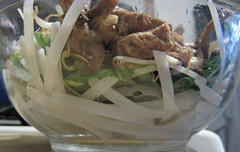
Noodles on bottom, with chard, bean sprouts, steak, and mushrooms piled on top before adding the broth.
As you can tell, this is a pretty simple dish, and pretty easy and quick to make if you cheat like I did. The salting of the steak before adding it to the pot may seem odd to many, but there's a very good reason for doing it that way. The first is that directly salting the meat will help break down the fibres in lower quality cuts, making them more tender in the end. The second reason is it pulls some of the juices out of the meat, and brings the salt in. This gives the meat itself some more flavor that you'd lose because of the short cooking time (if you salted the broth directly, the meat would loose a lot of flavor).
Now, as I noted, you can use all sorts of "additions" to your pho. The traditional ones are basil, cilantro, bean sprouts, sliced chilis, and a lime wedge. For the picture above, you can see (well, more read) that I used some chard from my garden. I just tore it into small pieces and added it directly to the bowl before adding the hot broth. Similar substitutions are more than accepted. The only thing you'll want to make note of is that you don't want to add a lot of cold/room temp. ingredients as it will cool the soup down too quickly (rice noodles get cold fast). Aside from that, feel free to experiment with what you have on hand. I'm pretty sure I'll be forced to add some zucchini in a few months.
So, I'm a day later than I hoped for, but I will promise a post in the next few days again. Cheers for now,
Mike

